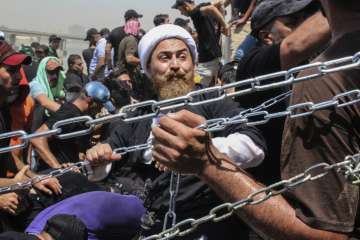Explained | Iraq's violent clashes and the political unstability
Iraq: Muqtada al-Sadr's supporters transformed the country’s government, Green Zone, into a front line, trading fire with security forces and rival militias, and bringing the capital to a standstill. 30 were killed and 400 were wounded in the clashes. What led to the situation? Read ahead to know.

Iraq clashes explained: At least 30 people were killed and 400 were injured in Iraq's capital Baghdad in clashes between Shia militias and Iraqi security forces after Muqtada al-Sadr said he was withdrawing from politics.
For 24 hours, Muqtada al-Sadr's supporters transformed the country’s government, Green Zone, into a front line, trading fire with security forces and rival militias, and bringing the capital to a standstill.
Just as quickly, with a single word — “withdraw” — from the cleric in a speech Tuesday, the fighting came to a stop. His supporters put down their weapons and left.
Following his calls for withdrawal, Iraqi leaders, including the caretaker premier, expressed their thanks to al-Sadr and praised his restraint.
But, what led to the crisis? Who is al-Sadr? And what do the protestors want?
Iraq's political crisis
Iraq has not had a stable government in 10 years. This is the longest since the United States attacked the country in 2003. In the last year's election, Muqtada al-Sadr's party had failed to secure a majority, leading to parties being unable to find a solution after the leader's party became the biggest faction. His refusal to negotiate with his Iran-backed Shiite rivals on forming a government plunged Iraq into an unprecedented political vacuum now in its tenth month.
Mohammed Shia al-Sudani was picked as the Prime Minister by the pro-Iran Coordination Framework - in what seemed to be the next best solution - leading to protests. The protestors stormed government buildings and staged protests to make Al-Sadr make the new premier of the country.
Who is Muqtada al-Sadr?
Al-Sadr is a populist cleric, who came emerged as a symbol of resistance against the U.S. occupation of Iraq after the 2003 invasion. He formed a militia, the Mahdi Army, that eventually disbanded and renamed it Saraya Salam — the Peace Brigades.
He has presented himself as an opponent of both the U.S. and Iran and has fashioned himself as a nationalist with an anti-reform agenda.
Al-Sadr derives much of his appeal through his family legacy. He is the son of Grand Ayatollah Mohammed Sadeq al-Sadr, who was assassinated in 1999 for his critical stance against Saddam Hussein. Many of his followers say they are devoted to him because they were once devotees of his father.
Al-Sadr eventually entered politics and garnered a reputation for being unpredictable and theatrical by frequently calling on his followers to gain political leverage over his rivals. His powerful rhetoric infused with religion and calls for revolution resonated deeply with his disenfranchised following.
Through these strategies, he has become a powerful player with a fiercely devoted grassroots following concentrated in Iraq’s most impoverished quarters. Most of his loyalists who stormed the Green Zone were unemployed and blamed the Iraqi political elite.
In 2021, al-Sadr’s party won the largest share of seats in the October parliamentary elections but not enough to secure a majority in government. His refusal to negotiate with his Iran-backed Shiite rivals on forming a government plunged Iraq into an unprecedented political vacuum now in its tenth month.
What do Al-Sadr's followers want?
The political crisis escalated in July when al-Sadr’s supporters broke into parliament to deter his rivals in the Coordination Framework, an alliance of mostly Iran-backed Shiite parties, from forming a government.
Hundreds staged an ongoing sit-in outside the building for over four weeks. Frustrated when he was not able to corral enough lawmakers to form a government that excluded his rivals, al-Sadr also ordered his bloc to resign their parliamentary seats and called for early elections and the dissolution of parliament.
That call was embraced and reiterated by his following, many of whom have long felt marginalized by the ruling elite.
The majority have roots in the rural communities of southern Iraq and have little education. Most face enormous challenges finding work. Most of those who stormed parliament in July and the government palace on Monday were young men for whom it was their first glimpse inside Iraq’s halls of power.
Angered by deep class divides and history of dispossession, al-Sadr’s followers say they believe the cleric will revolutionize a political system they believe has forgotten about them.
Iran's involvement
Iran shares a 1,599-kilometer border with Iraq. The recent clashes are the product of months of political tensions and power struggles between al-Sadr and the Iran-backed Shiite camp over the formation of the next government.
The greatest threat to Iraq’s stability is protracted armed fighting between the paramilitary forces of the rival Shiite camps.
Militiamen loyal to al-Sadr stormed the headquarters of Iran-backed militia groups in the southern provinces, a move that could have escalated into tit-for-tat attacks as has happened in the past.
It's a scenario that neighbouring Iran, which wields much influence in Iraq, dreaded most. Iranian officials, including Iran’s Supreme Leader Ayatollah Ali-Khamenei, have repeatedly called for Shiite unity and attempted to broker dialogue with al-Sadr. But the cleric has refused, firm in his resolve to form a government without Iran-backed groups.
Members of Iraq’s majority Shiite Muslim population were oppressed when Saddam Hussein ruled the country for decades. The 2003 U.S.-led invasion that toppled Saddam, a Sunni, reversed the political order. Just under two-thirds of Iraq is Shiite, with a third Sunni.
Now, the Shiites are fighting among themselves, with those backed by Iran and those who consider themselves Iraqi nationalists jockeying for power, influence and state resources.
History through pictures
(with inputs from agencies like AP, PTI)